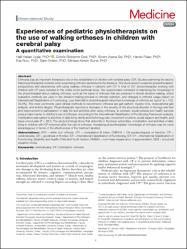| dc.contributor.author | Uysal, Halil Hakan | |
| dc.contributor.author | Özel, Cemile Bozdemir | |
| dc.contributor.author | Sel, Sinem Asena | |
| dc.contributor.author | Fidan, Hande | |
| dc.contributor.author | Burc, Eda | |
| dc.contributor.author | Erdem, Sabri | |
| dc.contributor.author | Günel, Mintaze Kerem | |
| dc.date.accessioned | 2025-10-13T09:41:12Z | |
| dc.date.available | 2025-10-13T09:41:12Z | |
| dc.date.issued | 2025 | en_US |
| dc.identifier.citation | Uysal HH, Ozel CB, Sel SA, Fidan H, Burc E, Erdem S, Gunel MK. Experiences of pediatric physiotherapists on the use of walking orthoses in children with cerebral palsy: A quantitative examination. Medicine 2025;104:40(e44835). | en_US |
| dc.identifier.issn | 1536-5964 | |
| dc.identifier.uri | https://journals.lww.com/md-journal/fulltext/2025/10030/experiences_of_pediatric_physiotherapists_on_the.132.aspx | |
| dc.identifier.uri | https://hdl.handle.net/20.500.12780/1243 | |
| dc.description.abstract | Orthoses play an important therapeutic role in the rehabilitation of children with cerebral palsy (CP). Studies examining the factors that physiotherapists consider when prescribing orthotics are limited in the literature. This study aimed to examine physiotherapists’ perspectives and experiences with using walking orthoses in patients with CP. A total of 207 physiotherapists working with children with CP were included in this online cross-sectional study. The questionnaire consisted of examining the knowledge of the physiotherapist about walking orthoses, such as the types of orthoses that are preferred in clinical decision-making, which evaluation methods are used in the decision-making process in orthosis selection, and changes in orthosis usage based on International Classification of Functioning. Less than half of physiotherapists rated their knowledge of orthotics as “good” (n = 102, 49.3%). The most commonly used clinical methods to recommend orthoses are gait pattern, muscle tone, observational gait analysis, and activity targets. Physiotherapists reported a decrease in the severity of the structural disorder in the legs and feet and improvement in participation in daily life and activities after using orthoses. In contrast, social policies and health services pose a major barrier to children’s use of orthoses. According to the International Classification of Functioning Framework analysis, mobilization was related to activities of daily living, family and technology use, movement functions, social support and health, and sleep-mood-pain (P < .001). The study’s findings show that deformity in the lower extremities, mobilization, and activities of daily living in children with CP improved after the use of orthoses. Increasing physiotherapists’ knowledge of orthoses may be more advantageous in terms of the effectiveness of the treatment applied. | en_US |
| dc.language.iso | eng | en_US |
| dc.publisher | Lippincott Williams and Wilkins | en_US |
| dc.relation.isversionof | 10.1097/MD.0000000000044835 | en_US |
| dc.rights | info:eu-repo/semantics/openAccess | en_US |
| dc.subject | Cerebral palsy | en_US |
| dc.subject | ICF | en_US |
| dc.subject | Mobilization | en_US |
| dc.subject | Orthoses | en_US |
| dc.title | Experiences of pediatric physiotherapists on the use of walking orthoses in children with cerebral palsy: A quantitative examination | en_US |
| dc.type | article | en_US |
| dc.contributor.department | İstanbul Kent Üniversitesi, Fakülteler, Sağlık Bilimleri Fakültesi, Fizyoterapi ve Rehabilitasyon Bölümü | en_US |
| dc.contributor.authorID | 0000-0002-5237-6267 | en_US |
| dc.contributor.institutionauthor | Fidan, Hande | |
| dc.identifier.volume | 104 | en_US |
| dc.identifier.issue | 40 | en_US |
| dc.relation.journal | Medicine | en_US |
| dc.relation.publicationcategory | Makale - Uluslararası Hakemli Dergi - Kurum Öğretim Elemanı | en_US |


















